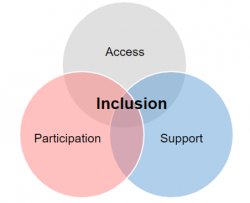Early Childhood Inclusion
In 2009, the Council for Exceptional Children – Division of Early Childhood (CEC-DEC) and the National Association for the Education of Young Children (NAEYC), came together and published a joint statement to define early childhood inclusion.
They identified the factors that define successful early childhood inclusion as Access, Participation, and Support.

Building upon these factors, the United States Department of Health and Human Services and the Department of Education released a joint policy statement in 2015 outlining best practices for inclusion of children with disabilities in early childhood programs. It set the vision and provides recommendations to states, local educational agencies, schools, and public and private early childhood programs for increasing the inclusion of infants, toddlers, and preschool children with disabilities in high-quality early childhood programs.
The vision of this joint policy statement is based on the democratic principle that equal opportunity is one of America’s most cherished ideals. Being meaningfully included as a member of society is the first step to equal opportunity and is every person’s right – a right supported by our laws.
Inclusion Success Factors
ACCESS: Providing access to a wide range of learning opportunities, activities, settings and environments is the first factor. Gaining access can include overcoming physical barriers in the school building or classroom environment, but also ensuring that every child has access to a developmentally appropriate general education curriculum.
PARTICIPATION: Even if environments are designed to facilitate access, some children will need additional individualized accommodations and support to participate fully in play and learning activities with peers and adults. These accommodations could include strategies like routine-based teaching or a focus on recognizing and supporting social and emotional development of young children.
SUPPORT: It is imperative to ask, what are the supports available for those who will be helping a child to participate and foster their sense of belonging? As we know, there is a need for systems-level support including professional development for general and special education early childhood administrators, educators, and allied professionals that allows for collaboration and communication between these school-based professionals and families.
